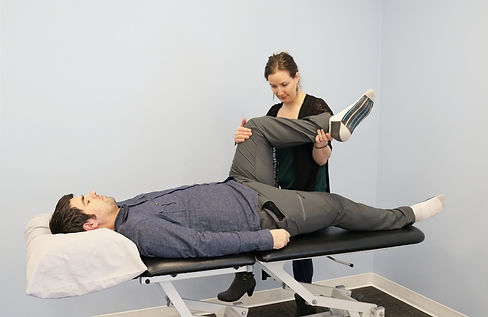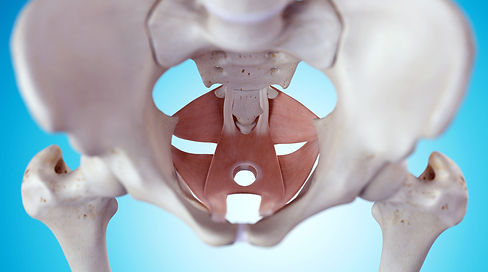
Manual Therapy
Manual therapy refers to the clinical approach of applying hands-on techniques to assess, mobilize, manipulate or massage a target area.
Mobilization
A slow and controlled process of joint and soft tissue stretching intended to increase bio-mechanical elasticity. It is a safe, gentle, and effective alternative to manipulations.
Manipulation
Movement of a joint to full range of motion followed by the application of a rapid rotation, shear, or distraction force. Typically is accompanied by a "pop" or "click" which is a release of pressure from within the joint.
Massage
The application of force and touch to soft tissues such as muscles, tendons, and ligaments without causing movement in the joints.
Kinesiology
The main goals of kinesiology is to train, educate, and equip clients with skills and movement resources to reach their goals and get them back to the activities that their condition has been preventing them from participating in.
The Kinesiologist works alongside your treating physiotherapist to ensure the gym program is safe, effective, and educational.
Kinesiology appointments can include but are not limited to:
-
Strength & conditioning for activities of daily living or athletics
-
Endurance and conditioning for return to work demand
-
Functional Abilities Evaluations


Pelvic Floor Therapy
Pelvic Health Physiotherapy involves the assessment and treatment of the pelvis and the associated muscles and tissues around the pelvis and hips. Advanced training in this area allows for the opportunity to assess these tissues via internal and external palpation, consisting of vaginal and/or rectal examination.
The pelvic floor is a sling of muscle that connect the tailbone to the pubic bone, and are therefore designed to support the pelvic organs (baldder, bowel, uterus) and spine, allow for sexual function, bowel and bladder control.
Pelvic health therapy can aide in the management of various symptoms or conditions such as (not limited to):
-
urinary and bowel incontinence
-
constipation
-
prenatal and postpartum care
-
peri/menopause
-
pelvic organ prolapse
-
pelvic/low back pain
Our pelvic health physiotherapist is trained to assess and treat both male and female individuals with pelvic health symptoms.

TMJ Treatment
The Temporomandibular joint (TMJ) is a complex joint involving a disc & must work in tandem with the joint on the opposite side of the body, as they are connected through the jaw. When the TMJ is not working optimally it can cause a lot of pain around the jaw, neck, ear, and can create problems with eating & talking.
Physiotherapy manual therapy, acupuncture & dry needling can help with TMJ concerns. Our intervention methods aim to help with the following:
-
realign a disc
-
release tight muscular structures both extra & intra-orally
-
increase mouth opening if reduced
-
reduce or eliminate clicking and/or pain
Vestibular Rehab
Vertigo and dizziness symptoms can significantly impact participation in daily activities and a person’s quality of life.
There are many reasons why someone can experience balance and vision problems. These may include but are not limited to:
-
Migraine associated vertigo (MAV)
-
Benign paroxysmal positional vertigo (BPPV)
-
Concussion related incidences
-
Neck injuries
-
History of inner ear infections
-
Sensory integration concerns
-
Meniere’s Disease
During a vestibular assessment we narrow down which areas are contributing to the problem and treat each source with specific head position sequences and targeted exercises.

Acupuncture
Acupuncture involves inserting small diameter needles into specific points of the body. Traditional Chinese acupuncture is based on the belief that the needles stimulate energy flow in the body. Western medical acupuncture adapts the Chinese approach and applies a scientific method to understand and explain its effects.
Acupuncture can cause changes in nerves, muscles, connective tissues, hormones, and circulation by stimulating specific points in the body. This impacts the muscular, skeletal, neurological, digestive, respiratory, urinary, and reproductive systems of the body. By stimulating specific points, the body may also release its natural pain killers endorphin and serotonin.
Dry Needling
Trigger Point
A trigger point is a muscle "knot" or irritable spot in soft tissue that may cause pain over a larger area. Too many of these trigger points can be called myofascial pain syndrome.
Trigger Point Dry Needling
Dry Needling uses a small diameter needle inserted through the skin and into the muscle, targeting and releasing myofascial trigger points. When the needle hits a trigger point it creates a local twitch reflex of the muscle. The twitch response has a therapeutic effect as research shows it will decrease muscle contraction by correcting the imbalance of certain chemical substances found in higher concentrations around trigger points. Hitting enough of these trigger points results in improved flexibility and less pain.


Electrotherapy
Electrotherapy is applied using electrodes around the targeted area. The electrotherapy device transmits electrical impulses through the targeted area stimulating the underlying tissues.
TENS (Transcutaneous Electrical Nerve Stimulation)
A TENS device stimulates the nerves via a low frequency small electrical current through the skin. TENS may provide short term pain relief through stimulations:
-
Sensory level stimulation of the nerves: the electrical impulses interfere with the transmission of pain signals to the brain.
-
Motor level stimulation of the muscles: the body releases natural pain relieving hormones.
IFC (Interferential Current)
Interferential current therapy is a deeper form of TENS which uses two frequencies of current. The higher frequencies penetrate deeper into the tissues and joints. The interference of the two frequencies produces an interferential current at a lower beat frequency. IFC therapy can penetrate deeper into the target area with less discomfort to the patient.
Spinal Traction
Spinal traction is a form of decompression therapy applied manually or mechanically to the neck or back. The mechanical application of traction uses a specially designed mechanical treatment bed with harnesses to stretch and take pressure off of compressed discs in the spine. This relieves pain and improves the bodies ability to heal itself.
Spinal traction can be used to treat:
-
Herniated discs
-
Sciatica
-
Degenerative Disc Disease
-
Pinched nerves
-
Other back conditions or injuries.


Ultrasound
Therapeutic ultrasound is applied with the contact face of an ultrasound probe. High frequency sound waves are transmitted from the transducer and into the local soft tissues of the targeted area. The ultrasound waves transmitted cause a vibration within the targeted area tissues which results in a local deep heating effect.
Therapeutic ultrasound is known to increase:
-
Healing rates
-
Tissue relaxation
-
Tissue heating
-
Local blood-flow which reduces swelling
-
Scar tissue breakdown

